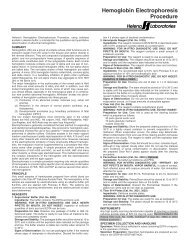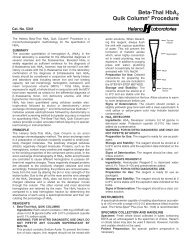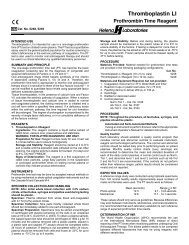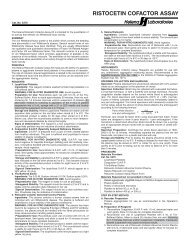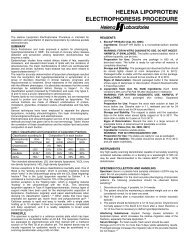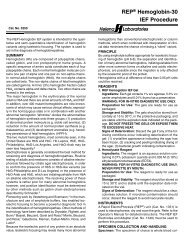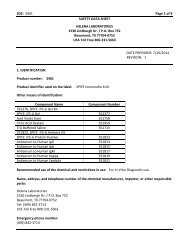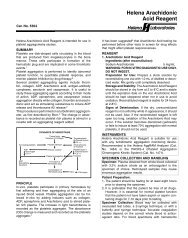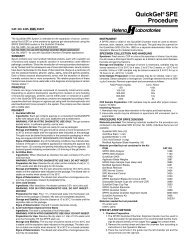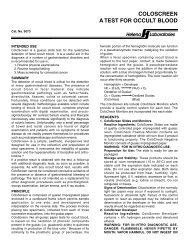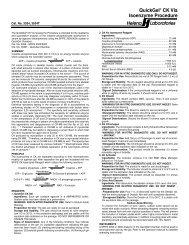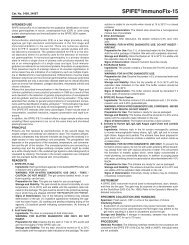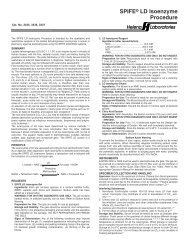TITAN GEL Serum Protein System - Helena
TITAN GEL Serum Protein System - Helena
TITAN GEL Serum Protein System - Helena
- No tags were found...
Create successful ePaper yourself
Turn your PDF publications into a flip-book with our unique Google optimized e-Paper software.
<strong>TITAN</strong> <strong>GEL</strong> <strong>Serum</strong> <strong>Protein</strong> <strong>System</strong>Cat. No. 3041<strong>Helena</strong>LaboratoriesThe <strong>Helena</strong> <strong>TITAN</strong> <strong>GEL</strong> <strong>Serum</strong> <strong>Protein</strong> <strong>System</strong> is intendedfor the separation and quantitation of serum proteinsby agarose gel electrophoresis.SUMMARY<strong>Serum</strong> contains over one hundred individual proteins,each with a specific set of functions and subject to specificvariation in concentration under different pathologicconditions. 1Since the introduction of moving-boundary electrophoresisby Tiselius 2 and the subsequent use of zone electrophoresis,serum proteins have been fractionated onthe basis of their electrical charge at a particular pH intofive classical fractions: albumin, alpha 1 , alpha 2 , beta andgamma proteins. Each of these classical electrophoreticzones normally contains two or more components.Approximately fifteen serum proteins have been studiedextensively because they may be measured easily. 3-5PRINCIPLE<strong>Protein</strong>s are large molecules composed of covalentlylinked amino acids. Depending on electron distributionsresulting from covalent or ionic bonding or structural subgroups,proteins can be either polar or nonpolar at agiven pH. In the <strong>TITAN</strong> <strong>GEL</strong> <strong>Serum</strong> <strong>Protein</strong> procedure,proteins are separated according to their respective electricalcharges at 8.4-8.8 on agarose gel using both theelectrophoretic and electroendosmotic forces present inthe system. The proteins are then stained with AmidoBlack staining solution.REAGENT1. <strong>TITAN</strong> <strong>GEL</strong> <strong>Serum</strong> <strong>Protein</strong> GelIngredients: Each gel contains agarose in barbitalbuffer with 0.01% thimerosal added as a preservative.WARNING: FOR IN-VITRO DIAGNOSTIC USEONLY.Preparation for Use: The gels are ready for use aspackaged.Storage and Stability: The gels should be stored atroom temperature (15 to 30°C) and are stable untilthe expiration date indicated on the package. Thegels must be stored in the protective packaging inwhich they are shipped. DO NOT REFRIGERATEOR FREEZE THE <strong>GEL</strong>S.Signs of Deterioration: Any of the following conditionsmay indicate deterioration of the gel: (1) crystallineappearance indicating the agarose has beenfrozen, (2) cracking and peeling indicating drying ofthe agarose, (3) bacterial growth indicating contamination.2. <strong>TITAN</strong> <strong>GEL</strong> <strong>Serum</strong> <strong>Protein</strong> BufferIngredients: The buffer is a barbital-sodium barbitalbuffer with 0.1% sodium azide added as a preservative;pH 8.4-8.8.WARNING: FOR IN-VITRO DIAGNOSTIC USEONLY. DO NOT INGEST.The buffer contains barbital which, in sufficient quantity,can be toxic. To prevent the formation of toxicvapors, sodium azide should not be mixed with acidicsolutions.When discarding reagents containing sodiumazide, always flush sink with copious quantities ofwater. This will prevent the formation of metallicazides which, when highly concentrated in metal, arepotentially explosive. In addition to purging with water,plumbing should occasionally be decontaminatedwith 10% NaOH.Preparation for Use: Dissolve one bag in 1500 mL ofdeionized water. The buffer is ready for use when allmaterial is completely dissolved.Storage and Stability: The packaged buffer shouldbe stored at 15 to 30°C and is stable until the expirationdate indicated on the package. Diluted buffer isstable two months at 15 to 30°C.Signs of Deterioration: Discard packaged buffer ifthe material shows signs of dampness or discoloration.Discard diluted buffer if it becomes turbid.3. Amido Black <strong>Protein</strong> StainIngredients: When reconstituted as directed, thestain contains 0.25% (w/v) Amido Black stain.WARNING: FOR IN VITRO DIAGNOSTIC USEONLY. DO NOT INGEST.Preparation for Use: Dissolve the dry stain (entirecontents of vial) in 1 L of the Fixative/Destain Solutionmade in the “Materials needed but not provided” section.Mix thoroughly for 30 minutes.Storage and Stability: The dry stain should bestored at 15 to 30°C and is stable until the expirationdate indicated on the package. The diluted stain isstable one year stored at 15 to 30°C.Signs of Deterioration: The diluted stain should be ahomogeneous mixture free of precipitate. Discard ifprecipitate forms.INSTRUMENTSAny high quality scanning densitometer with visibletransmittance capability may be used to scan the gels.Recommended is the <strong>Helena</strong> EDC ® (Cat. No. 1376), theCliniScan TM 2 (Cat. No. 1260) or the CliniScan 3 (Cat.No. 1680). Refer to the Operator’s Manual for detailedinstructions.SPECIMEN COLLECTION AND HANDLINGSpecimen: The specimen may be serum, plasma, urineor cerebrospinal fluid. Use of plasma will cause a fibrinogenband to appear as a distinct narrow band betweenthe beta and gamma fractions.Interfering Factors:1. Hemolysis may cause false elevation in the alpha 2and beta fractions.
2. Inaccurate results may be obtained on specimens leftuncovered, due to evaporation.Storage and Stability: Fresh serum or plasma is thespecimen of choice. If storage is necessary, samplesmay be stored covered at 15 to 30°C for 4 days or 2 to6°C for 2 weeks, or -20°C for 6 months. 7 Cerebrospinalfluid and urine specimens may be used after proper concentration(10-50X) with a concentrator.PROCEDUREMaterials provided: The following materials needed forthe procedure are contained in the <strong>TITAN</strong> <strong>GEL</strong> <strong>Serum</strong><strong>Protein</strong> Kit (Cat. No. 3041). Individual items are not available.<strong>TITAN</strong> <strong>GEL</strong> <strong>Serum</strong> <strong>Protein</strong> Gels (10)<strong>TITAN</strong> <strong>GEL</strong> <strong>Serum</strong> <strong>Protein</strong> Buffer (1 pkg)Amido Black <strong>Protein</strong> Stain (1 vial)<strong>TITAN</strong> <strong>GEL</strong> Blotter A (20)<strong>TITAN</strong> <strong>GEL</strong> SPE Templates (10)Materials provided by <strong>Helena</strong> Laboratories but notcontained in the kit:ITEMCAT. NO.Dialamatic Microdispenser and Tubes 6210SPE Control 5136<strong>TITAN</strong> <strong>GEL</strong> Chamber 4063I.O.D. (Incubator, Oven, Dryer) 5116Titan Plus Power Supply 1504<strong>TITAN</strong> <strong>GEL</strong> Multi-Staining Set 1558Titan Blotter Pads 5037Materials needed but not provided:Glacial Acetic AcidMethanolFixative/Destain Solution: Mix 1 L methanol, 1 Ldeionized water and 200 mL glacial acetic acid. Mixwell. Use 1 L of this solution to prepare the stain solutionand the remainder for destaining the gels.SUMMARY OF CONDITIONSGel . . . . . . . . . . . . <strong>TITAN</strong> <strong>GEL</strong> <strong>Serum</strong> <strong>Protein</strong> GelBuffer Dilution . . . . . . . . . . . . . . . . . . . . 1500 mLSample Dilution . . . 1 part sample + 3 parts bufferSample Volume . . . . . . . . . . . . . . . . . . . . . . 3 µL<strong>Serum</strong> Absorption Time. . . . . . . . . . . . . 4 minutesElectrophoresis Time . . . . . . . . . . . . . 15 minutesVoltage. . . . . . . . . . . . . . . . . . . . . . . . . . . . 120 VDrying Time . . . . . . . . . . . . . . . . . . . . . 5 minutesStaining Time . . . . . . . . . . . . . . . . . . . 10 minutesDestaining Time . . . . . . . . . . . . . . . . 2 x 1 minuteDrying time (after destaining) . . . . . . . . 5 minutesScanning Wavelength . . . . . . . . . . . . . . . 595 nmRecommended EWC Parameters:Buffer volume; mL per chamber section . . . 20 mLElectrophoresis Voltage . . . . . . . . . . . . . . . . 85 VElectrophoresis Time . . . . . . . . . . . . . 20 minutesStaining Time . . . . . . . . . . . . . . . . . . . 10 minutesIncubation Time/Temp . . . . . . . . . . . . . . . . . . N/ADrying Time . . . . . . . . . . . . . . . . . . . . 15 minutesDrying Temperature . . . . . . . . . . . . . . . . . . . 55°CSTEP-BY-STEP METHODA. Preparation of the <strong>TITAN</strong> <strong>GEL</strong> CHAMBER1. Dissolve one bag of <strong>TITAN</strong><strong>GEL</strong> <strong>Serum</strong> <strong>Protein</strong> Bufferin 1500 mL of deionizedwater.2. Pour approximately 25 mLof diluted buffer into eachinner section of the chamber.3. Cover the chamber until ready to use.B. Sample Application1. Dilute each patient sample and control 1:4 (1 partsample + 3 parts buffer) with <strong>TITAN</strong> <strong>GEL</strong> <strong>Serum</strong><strong>Protein</strong> Buffer.2. Remove the <strong>TITAN</strong> <strong>GEL</strong> <strong>Serum</strong> <strong>Protein</strong> Gel fromthe protective packaging. One edge of the agarosegel has been numbered for easy sample placementand identification.3. Using Blotter A, gently blot theBlotter Aapplication area of the gelusing a slight fingertip pressureon the blotter.Gel4. Carefully place the <strong>TITAN</strong><strong>GEL</strong> SPE Template on the1 2 3 4 5 6 7 8 9 10gel, aligning the applicationslits with the zerosigns (0) on the sides of+the gel and trying to avoidtrapping any air bubbles<strong>TITAN</strong> <strong>GEL</strong> SPunder the template. Placea Blotter A over the templateand remove any bubblesin the slit area withslight fingertip pressure.Retain the blotter for usein Step 7.5. Place 3.0 µL of each sampleonto the template slits, spreading the samplecompletely over the entire slit. Apply the samplesas quickly as possible.6. Wait 4 minutes after the last sample has beenapplied to allow the samples to diffuse into theagarose.7. Gently blot the templateBlotter Awith the Blotter A retainedin Step 4 and then carefullyremove the blotter.SPE Template8.Wait 30 seconds and thencarefully remove the template.C. Electrophoresis of the Sample Gel1. Quickly place the gel into the inner section of thechamber, agarose side down, by gently squeezingthe gel into place. Position the gel so that the edgesof the agarose are in the buffer and the application-++
point is on the cathodic (-) side. Two gels may beelectrophoresed at one time.2. Place the cover on the chamber and insure that thecover does not touch the gel. Electrophorese thegel(s) at 120 volts for 15 minutes.D. Visualization of the <strong>Protein</strong> Bands1. At the end of the electrophoresis period, remove thegel from the chamber and place it in methanol for 5minutes.2. Remove the gel from the methanol and lay it on ablotter. Then place it into an I.O.D., or other laboratorydrying oven with forced air at 60-70°C for 5minutes or until dry. The gel may be dried at a lowertemperature but additional time will be required.The gel will not destain properly if it is not completelydry.3. Fill one container of the Staining Set with preparedstain. Fill another container with Fixative/DestainSolution.4. Remove the gel from the oven and place it in theStaining Rack. Immerse the rack into the stain for10 minutes.5. Remove the rack from the stain and allow it to drainon a blotter. Destain the gel by rinsing it in two (2)consecutive washes of destain solution. Allow thegel to remain in each wash for 1 minute. The gelbackground should be completely clear. If the gelbackground is not completely clear, a final waterwash should be used to remove trace amounts ofstain. Place the gel in tap water for 1 minute afterdestaining it. Wipe the back of the gel with laboratorytissue dampened with methanol to remove anyremaining stain.6. Dry the destained gel by placing it on a blotter andinto an I.O.D., or other drying oven at 60-70°C untildry.E. Evaluation of the <strong>Protein</strong> BandScan the dried <strong>TITAN</strong> <strong>GEL</strong> <strong>Serum</strong> <strong>Protein</strong> Gel at595 nm.Stability of End ProductThe completed, dried <strong>TITAN</strong> <strong>GEL</strong> <strong>Serum</strong>m <strong>Protein</strong> Gel isstable for a indefinite period of time.Quality ControlSPE Control (Cat. No. 5136) may be used to verify allphases of the procedure and should be used on each gelrun. Refer to the package insert provided with the controlfor assay values.RESULTSFigure 1 illustrates the electrophoretic mobilities of thealbumin, alpha 1 , alpha 2 , beta and gamma protein bandson <strong>TITAN</strong> <strong>GEL</strong> <strong>Serum</strong> <strong>Protein</strong> Gel. The fastest movingband, and normally the most prominent, is the albuminband found closest to the anodic edge of the gel. Thefaint band next to this is alpha 1 , globulin, followed byalpha 2 globulin, beta and gamma globulins.Figure 2 illustrates a typical densitometric tracing producedwith the <strong>Helena</strong> EDC. The protein bands arelabeled as they appear in a normal protein pattern.Cathode(–)Anode(+)GammaBetaAlpha 2Alpha 1AlbuminFigure 1: <strong>TITAN</strong> <strong>GEL</strong> <strong>Serum</strong> <strong>Protein</strong> Gel illustrating theelectrophoretic mobilities of albumin and alpha 1 , alpha 2 ,beta and gamma globulins.Figure 2: Densitometric tracing of serum protein electrophoresispattern.Calculation of the Unknown:The <strong>Helena</strong> EDC Densitometer and other <strong>Helena</strong> densitometerswith computer accessories will automaticallyprint the relative percent and the absolute values foreach band. Refer to the Operator’s Manual provided withthe densitometer.REFERENCE VALUESThe reference values for serum protein electrophoresison the <strong>TITAN</strong> <strong>GEL</strong> <strong>Serum</strong> <strong>Protein</strong> <strong>System</strong> are presented.These values are presented as a guideline. Each laboratoryshould establish its own normal range study.<strong>Protein</strong> Fraction % of Total <strong>Protein</strong>Albumin 52.3 - 66.0Alpha 1 3.3 - 7.0Alpha 2 6.3 - 11.7Beta 7.8 - 14.3Gamma 11.1 - 20.4Variations of Expected Values 4Studies show that values are the same for both malesand nonpregnant females. Some differences are seen inpregnant females at term and in women on oral contraceptives.Age has some effect on normal levels. Cordblood has decreased total protein, albumin, alpha 2 andbeta fractions; slightly increased alpha 1 and normal orincreased gamma fractions (largely of maternal origin).The gamma globulins drop rapidly until about three
months of age, while the other fractions have reachedadult levels by this time. Adult levels of the gamma globulinsare not reached until 10-16 years of age. The albumindecreases and beta globulin increases after the ageof 40.Further Testing RequiredThe serum protein electropherogram or densitometrictracing should be evaluated for abnormalities. If abnormalitiesare observed, appropriate follow-up studiesshould be initiated. These may include immunoelectrophoresis,immunofixation, quantitation of immunoglobulins,bone marrow examination and other appropriatetests.INTERPRETATION OF RESULTS 5, 6Results on normal individuals will cover age and sexrelatedvariations and day-to-day biologic variations.Disease states in which abnormal patterns are observedinclude inflammatory response, rheumatic disease, liverdiseases, protein-loss disorders, monoclonal gammopathies,pregnancy and genetic deficiencies.LIMITATIONSSince all electrophoretic procedures are nonlinear, it iscritical to use the recommended volume of undilutedserum to obtain optimal resolution and reproducibleresults. Noncompliance with the recommended proceduremay affect the results.SPECIFIC PERFORMANCE CHARACTERISTICSPrecision: Within-Run and Run-to-Run precision studiesyielded CV’s of less than 10%.Sensitivity: The sensitivity of the system, using theAmido Black <strong>Protein</strong> Stain, is 10 µg/dL.Comparison: A comparison study of this method to thecellulose acetate method, using a range of 4.48 g/dL-11.85 g/dL, was excellent yielding a linear regressionequation of Y = 0.996X + 0.072 (where X is the <strong>TITAN</strong><strong>GEL</strong> method and Y is the cellulose acetate method) anda correlation coefficient of 0.998.BIBLIOGRAPHY1. Alper, C.A., Plasma <strong>Protein</strong> Measurements as aDiagnostic Aid, N Eng J Med, 291:287, 1974.2. Tiselius, A., A New Approach for ElectrophoreticAnalysis of Colloidal Mixtures, Trans Faraday Soc,33:524,1937.3. Ritzmann, S.E. and Daniels, J.C., Diagnostic<strong>Protein</strong>ology: Separation and Characterization of<strong>Protein</strong>s, Qualitative and Quantitative Assays, inLaboratory Medicine, Harper and Row, Inc.,Hagerstown, 1979.4. Ritzmann, S.E. and Daniels, J.C., <strong>Serum</strong> <strong>Protein</strong>Abnormalities: Diagnostic and Clinical Aspects, AllenLess Co., 1982.5. Killingsworth, L.M. et al., <strong>Protein</strong> Analysis, Diag Med,3-15, Jan/Feb, 1980.6. Killingsworth, L.M., Plasma <strong>Protein</strong> Patterns in Healthand Disease, CRC Crit Rev in Clin Lab Sci, August,1979.7. Tietz, N.W., ed., Textbook of Clinical Chemistry, 3rded., W.B. Saunders Co., Philadelphia, pg 524, 1995.<strong>TITAN</strong> <strong>GEL</strong> SERUM PROTEIN KIT Cat. No. 3041<strong>TITAN</strong> <strong>GEL</strong> <strong>Serum</strong> <strong>Protein</strong> Gels (10)<strong>TITAN</strong> <strong>GEL</strong> <strong>Serum</strong> <strong>Protein</strong> Buffer (1 pkg.)Amido Black <strong>Protein</strong> Stain (1 vial)<strong>TITAN</strong> <strong>GEL</strong> Blotter A (20)<strong>TITAN</strong> <strong>GEL</strong> SPE Templates (10)Other Supplies and EquipmentThe following items, needed for performance of the<strong>TITAN</strong> <strong>GEL</strong> <strong>Serum</strong> <strong>Protein</strong> Procedure, must beordered individually.Cat. No.Dialamatic Microdispenser and Tubes 6210<strong>TITAN</strong> <strong>GEL</strong> Chamber 4063I.O.D. (Incubation and Drying Oven) 5116<strong>TITAN</strong> <strong>GEL</strong> Multi-Staining Set 1558SPE Control (1 x 2 mL) 5136Titan Plus Power Supply 1504Titan Blotter Pads 5037For Sales, Technical and Order Information and ServiceAssistance, call 800-231-5663 toll free.<strong>Helena</strong> Laboratories warrants its products to meet our published specifications and to be freefrom defects in materials and workmanship. <strong>Helena</strong>’s liability under this contract or otherwiseshall be limited to replacement or refund of any amount not to exceed the purchase price attributableto the goods as to which such claim is made. These alternatives shall be buyer’s exclusiveremedies.In no case will <strong>Helena</strong> Laboratories be liable for consequential damages even if <strong>Helena</strong> hasbeen advised as to the possibility of such damages.The foregoing warranties are in lieu of all warranties expressed or implied including, but not limitedto, the implied warranties of merchantability and fitness for a particular purpose.Shaded areas indicates that text has been modified, added ordeleted.<strong>Helena</strong> Laboratories Pro 51Beaumont, Texas3/00(7)



